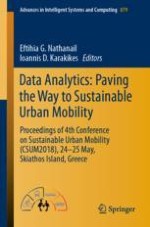2019 | OriginalPaper | Buchkapitel
Health Related Benefits of Non-motorised Transport: An Application of the Health Economic Assessment Tool of the World Health Organisation to the Case of Trikala, Greece
verfasst von : Pantoleon Skayannis, Marios Goudas, Diane Crone, Nick Cavill, Sonja Kahlmeier, Vasilena Mitsiadi
Erschienen in: Data Analytics: Paving the Way to Sustainable Urban Mobility
Aktivieren Sie unsere intelligente Suche, um passende Fachinhalte oder Patente zu finden.
Wählen Sie Textabschnitte aus um mit Künstlicher Intelligenz passenden Patente zu finden. powered by
Markieren Sie Textabschnitte, um KI-gestützt weitere passende Inhalte zu finden. powered by
